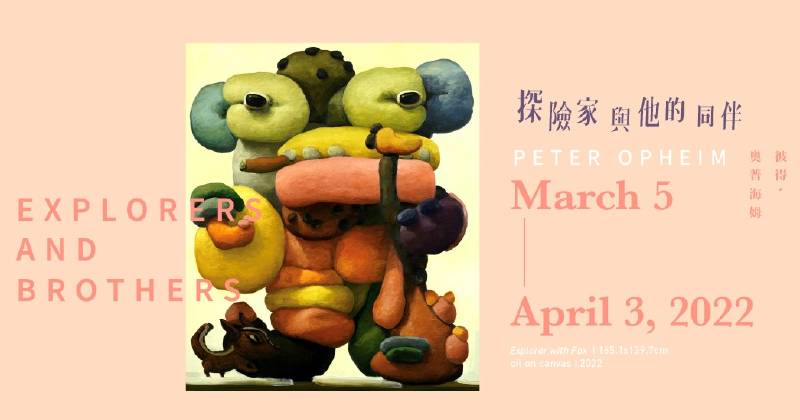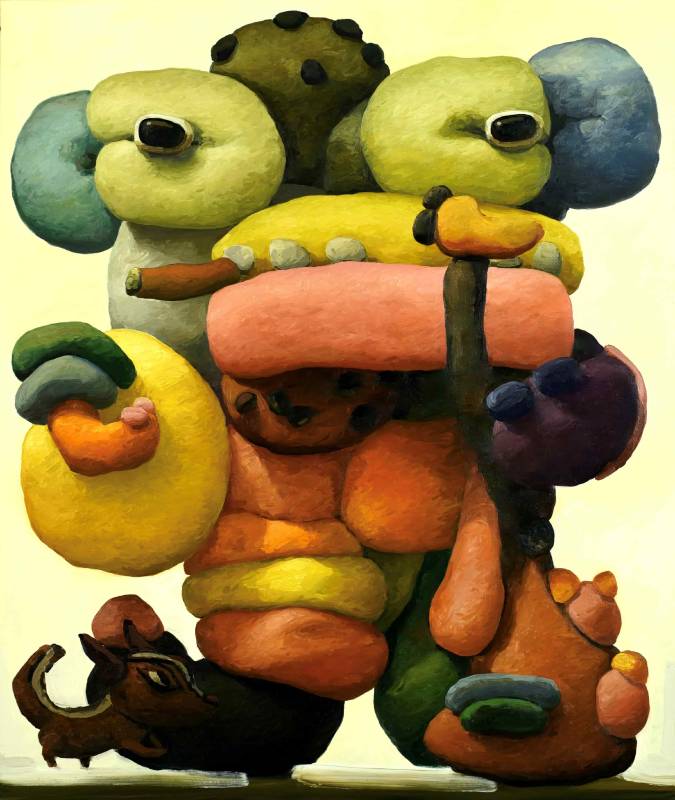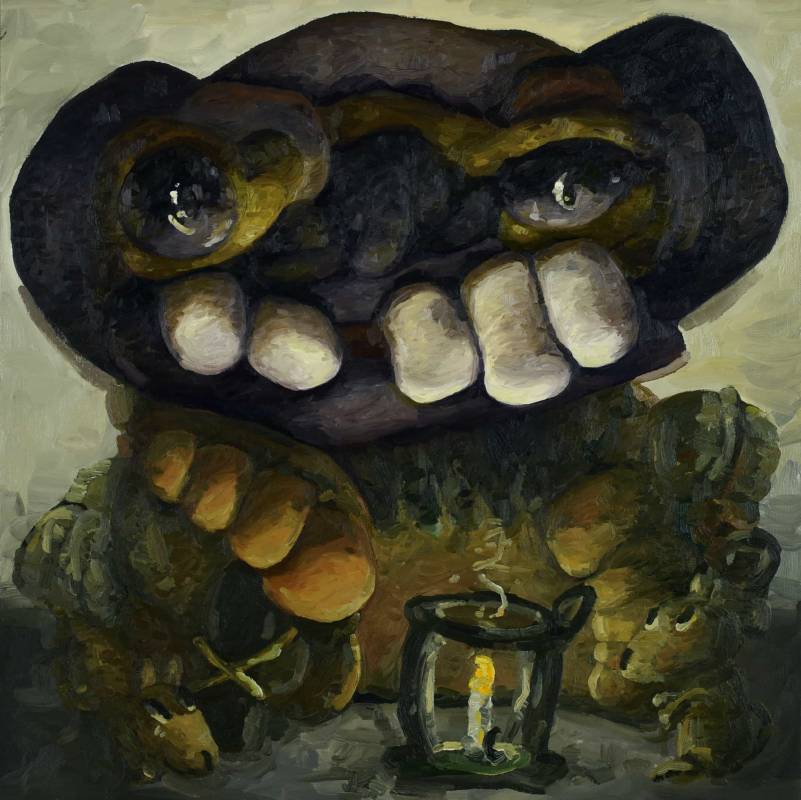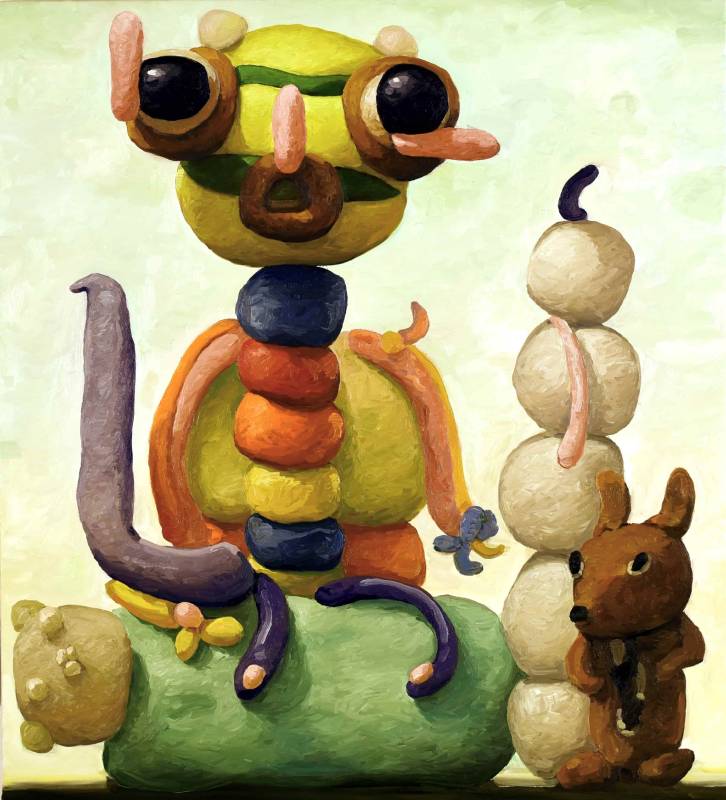紅野畫廊
【彼得.奧普海姆 : 探險家與他的同伴】Peter Opheim: Explorers and Brothers

-
展期
日期:2022-03-05 ~ 2022-04-03
-
地點
台北市中山區松江路164巷11號
-
相關連結
Powen Gallery Instagram
Powen Gallery Facebook
Powen Gallery Website -
參展藝術家
彼得.奧普海姆 Peter Opheim
-
彼得.奧普海姆:探險家與他的同伴
Peter Opheim: Explorers and Brothers
藝術家 Artist | 彼得.奧普海姆 Peter Opheim
展期 Duration | March 5 – April 3, 2022
線上展間 Online Viewing Room|https://onlineviewingroom.com/exhibition/EVJYWKU8AZCG/
地點 Venue | 紅野畫廊 Powen Gallery(台北市中山區松江路164巷11號,10:00-19:00 週一休館 Closed on Mondays)
彼得.奧普海姆創作中的精靈與兩個世界
文 / 胡鐘尹
(自由撰稿人 / 藝評)
「神話指使人在不知不覺中將它們想出來」–李維史陀(Claude Lévi-Strauss)(1)
初見奧普海姆的創作,觀者首先容易受他創造的各種奇特生物,與精靈的形象所吸引,這些生物和其伴隨建構的世界,總是帶給人愉悅的感受,並且我們也可從他的創作中,找到一條理解小徑,進入他的心靈世界。
這條小徑,不必然是用卡通化(cartoonish)或「萌」(もえ)的視角解讀來看,而是由一條透過形象載體(生物與精靈的符號特徵),產生想像情境與意義的傳達,而我們可將他的繪畫與創作,視為一種對哲理、超然之物與現實世界銜接產生的語言翻譯,凸顯兩個世界之間的關係性連結。他們一方面以有形的物象形式代表現實世界,另一方面則藉由觀想中的超驗(transcendent)(2),牽引觀者潛渡至想像的另類真實世界。
奧普海姆運用各種顏色的黏土,捏成小雕塑,再轉換為平面繪畫。這些源自他在日常體驗到的事件、哲思、音樂、文學或其它靈感,以一種形象化的「生命狀態」成為繪畫中的精靈,而非一個個純粹的符號物件。雖然「現實世界」與「真實世界」在概念上帶有某種“事實”與“心理感受”上的二元差異,但這對奧普海姆創造的精靈生物來說,在潛入的世界裡凸顯的生命狀態與存在,更如一種自由的游移與穿越。
自想像創造出的雕塑,經過繪畫的介面轉換,會再次透過靈感、感受、自我啟發與色彩造型的觸動,進行二次的抽離。原初藝術家心中的預見,轉換為觸感形式的物體,再由物體還原至帶有語言傳達特質的平面繪畫。奧普海姆意欲讓他創作裡的精靈,有自帶生命的可能性,他們雖以想像為存在基礎,卻是以另一種形象語言存在的真實。
「意義」作為一種連接人類想像與真實之間的具體表現,李維史陀和羅蘭.巴特(Roland Barthes),都曾以人類學視角、語言學與符號學等角度,談及神話在人類歷史文明演進中扮演的獨特角色和象徵。
羅蘭.巴特首先指出:「神話是一種言談(parole),當然,語言必須具備特殊條件,才會成為神話。(…)神話是一種溝通系統,一種訊息。神話不可能是一個物品、一項概念、一種看法,它是一種溝通模式,一種形式。」、「所有的神話材料,不論是再現性或文字性的,都預設了一種產生意義的意識。」(3)
而李維史陀在《神話與意義》的演講中更指出:「意義(meaning) 這個字可能是整套語言裏面,其意義最難以尋獲的一個詞。『意思是』(to mean)究竟是什麼意思?我覺得我們可以給的唯一答案,似乎是:『意思是』代表一種能把任何資料翻譯成另一種語言的能力。」(4)
「神話」使用不同的形象與人物性格,傳遞著思想的溝通及反思,奧普海姆的「精靈」,也同樣扮演著這般重要的角色,在感知中獲取意義,他以開放性的想像語言創造精靈形象,並與自然宇宙產生內在連結。
----------------------------------
註1:克勞德.李維史陀(Claude Lévi-Strauss)著、楊德睿譯:《神話與意義》,臺北市:麥田,城邦文化出版,2010年,頁16。
註2:德國哲學家康德(Immanuel Kant)區分人的認識中,經驗的狀態有三種,分別是以人的感性能力可獲取的現實世界直觀內容「經驗」(後天經驗 a posteriori)、「先驗」(先天經驗 a priori)先於經驗卻不依賴經驗而改變的先天認識,以及「超驗」(transcendent),超出於經驗世界而無法被人的理性認識,例如鬼神、夢境的想像之物,上帝等。
註3:羅蘭.巴特(Roland Barthes)著、江灝譯:《神話學》,臺北市:麥田,城邦文化出版,2019年,頁314–315、317。
註4:同註1,頁31–32。
—
Peter Opheim: Explorers and Brothers
Artist | Peter Opheim
Duration | March 5 – April 3, 2022
Online Viewing Room|https://onlineviewingroom.com/exhibition/EVJYWKU8AZCG/
Venue | Powen Gallery (No.11, Ln. 164, Songjiang Rd., Zhongshan Dist., Taipei City 104, Taiwan / 10:00-19:00 Closed on Mondays)
The Creatures and Two Worlds in Peter Opheim’s Oeuvres
Written by HU Jungyi
(Art Critic)
“Myths get thought in man unbeknownst to him.” ― Claude Lévi-Strauss (1)
When seeing Opheim's creations for the first time, the audience is easily drawn in by the strange creatures and images of figures he has created. These creatures and the world they construct invariably induce a sense of happiness. From his creations, we can also find a path of understanding into his spiritual world.
The interpretation of this path is not necessarily based on the perspective of the objects being cartoonish or possessing qualities of “cuteness” (moe, Japanese: 萌え). Rather, it is the generation of imaginary situations and the conveyance of meanings through the image carriers (the symbolic characteristics of creatures and figures). We can regard Opheim’s paintings and creations as a kind of language translation of the connection between philosophy, transcendent beings, and the real world to highlight the association in the middle of the two worlds. On the one hand, they represent the real world in the form of tangible objects; and on the other, through transcendent (2) visualization, they lead the audience to delve into an alternative real world of the imagination.
Opheim kneads clay of various colors into miniature sculptures and transforms them into two-dimensional paintings. The events, philosophical ideas, music, literature, or other inspirations he experiences in daily life become the figures in his paintings in the form of “life state” imageries rather than pure symbolic objects. Although the concept of “real world” and “authentic world” comprises a kind of binary difference between “fact” and “psychological feeling”, for the figures created by Opheim, their highlighted life state and existence in the world in which they dwell is a form of free wandering and traversal.
The sculptures, created from his imagination and transformed via the interface of painting, undergo a second detachment through inspiration, feeling, self-inspiration and color-shaping. The original vision in the mind of the artist is transformed into objects in the form of tactile sensations, then restored from objects into two-dimensional paintings that are imbued with the characteristics of language transmission. Opheim endeavors to give the figures in his creations the possibility of their own lives. Although derived from imagination, they are realized as another form of figurative language.
“Meaning” is a concrete expression connecting human imagination and reality. Lévi-Strauss and Roland Barthes had talked about the unique roles and symbols of myths in the evolution of human history and civilization from the perspectives of anthropology, linguistics, and semiotics.
Roland Barthes first pointed out that “Myth is a type of speech. Of course, it is not any type: language needs special conditions in order to become myth (...) myth is a system of communication, that it is a message. This allows one to perceive that myth cannot possibly be an object, a concept, or an idea; it is a mode of signification, a form.” “... all the materials of myth (whether pictorial or written) presuppose a signifying consciousness.” (3)
In his speech “Myth and Meaning”, Lévi-Strauss pointed out that “the word ‘meaning’ is probably, in the whole language, the word the meaning of which is the most difficult to find. What does ‘to mean’ mean? It seems to me that the only answer we can give is that ‘to mean’ means the ability of any kind of data to be translated in a different language.” (4)
“Myth” uses different imageries and characters to convey the communication and reflection of ideas. Opheim's “creatures” also play such an important role. Acquiring meaning through perceptions, he uses open, imaginative language to create the image of figures and generate inner connections with the natural universe.
----------------------------------------
Note 1: Claude Lévi-Strauss, translated by Yang Te-Jrui, (2010). Myth and Meaning, (pp. 16). Taipei: Rye Field Publishing Co - Cite Publishing Ltd.
Note 2: The German philosopher Immanuel Kant divides human cognition into three states of experience. These are: “a posteriori experience”, which is a real-world intuitive content "experience" that can be acquired by human perceptual ability; “a priori experience”, which is innate knowledge that precedes but does not depend on experience; and “transcendent experience”, which is beyond the world of experience, such as ghosts, imaginary things in dreams, and God, all of which cannot be recognized via human reasoning.
Note 3: Roland Barthes, translated by Chiang Hao, (2019). Mythologies, (pp. 314–315, 317). Taipei: Rye Field Publishing Co - Cite Publishing Ltd.
Note 4: Same as Note 1, pp. 31–32.
-
REFERENCE
Powen Gallery Instagram
Powen Gallery Facebook
Powen Gallery Website






